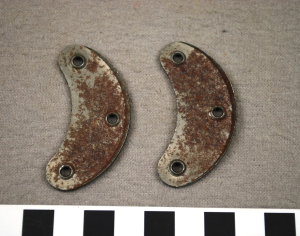The image above is of a pair of silver colored metal taps, but what are taps? Taps are used for shoe repair, preventative shoe care, rhythm, beat, music and dance. When placed on the bottoms of shoes at the toe and heel, a damaged shoe can be repaired or transformed into an instrument for your feet. When people imagine taps for shoes most think of tap shoes. We see images of Irish Riverdance, clogging, tap dancing and fraternity and sorority stepping. Yet, taps are also used for shoe repair. These silver colored metal taps can be found in a variety of sizes. Some are large enough for a man’s boots or small enough for a pair of women’s heels.
As the soles of shoes are worn down an owner can send them to a cobbler, a person who mends shoes, and have the sole replaced in areas of increased use. We tend to wear down the tips and heels of our shoes the fastest because of how we walk. After the soles of the shoes are replaced an option to make them last even longer could be to place a heel cap and a toe tap on the bottom of the shoe. The cobbler must first repair the sole by cutting and shaping a new piece of rubber or leather. Then they can apply the tap with either glue or nails. This prevents the sole of the shoe from being worn away as quickly because the areas that wear out the fastest are now covered in metal. Not all taps are silver in color either. Some are black to match the bottom of black-soled shoes. Also, other materials, such as plastics, are now being used to make a much quieter tap.
The last thing a tap dancer needs though is a quieter tap for their shoes. Taps on tap shoes tend to be much larger and take up the entire shoes’ heel and tip. The tele-tone tap is one of the most common taps used on tap shoes. The tele-tone tap is metal with up to three screws holding it in place. Unlike taps for repair, taps for dancers are either nailed or screwed on. Dancers like the tele-tone taps because they are held in place by three screws that can be adjusted to create different sounds, or notes as some dancers refer to them. There are many aspects to the construction of the tap shoes that can change the sound, other than the taps themselves. If the taps are applied to an uneven surface or if the heel of the shoe is made of plastic, the quality of the sound will change. Dancers must care for their taps as well. While taps may be used to repair and maintain dress shoes, the metal can still be thinned down over time. Tap care is just as important as caring for the shoes themselves. With extensive use the metal thins, changing the dancers notes.
Some claim the first metal taps were produced around the 1930s but the art of tap dance took on many forms throughout history. Tap dance in its earliest form was clogging. In the early 1700s in parts of southern Appalachia, Irish, Dutch-German, Scottish and English immigrants would hold dances for entertainment. People would gather together and make up different steps, stomping their feet and teaching it to others. Over time they incorporated aspects of traditional Native American dances and African American rhythmic beats. Tap dance would emerge from clogging and introduce taps to the sole of shoes. The earliest showcasing of tap dancing was in minstrel shows just after the Civil War. A minstrel show was often a comedy act, usually performed for a white audience by African Americans. The intent was to portray a stereotyped image of African Americans, shuffling around and tapping their feet. These shows were designed to calm fears of uprising and rebellion after slavery was abolished. As time went on and tap dance became more recognized as a form of folk-art. Tap dance moved its way into the world of Jazz and Modern dance. Some elite women’s colleges began to teach tap dance in the 1930s and a new act was born. On the stages of Broadway and Hollywood tap dancers stood tall.
One of the most notable tap dancers of the time was Eleanor Powell. In 1936 Hollywood’s MGM Studio produced the film Born to Dance starring Eleanor Powell. She was never formally trained as a tap dancer. She took a handful of lesson so she could get work on Broadway and ended up in films alongside many other greats of her time like Fred Astaire, making music with their feet.
The most unique aspect of tap dance is its ability to take on any musical form. Dancers can make their own beat and create a song of their own or they can mimic the music. Taps have rich stories behind them, one of bringing immigrant groups together, another of oppression, yet in the end they became a form of folk-art that would influence modern dance to this day.
